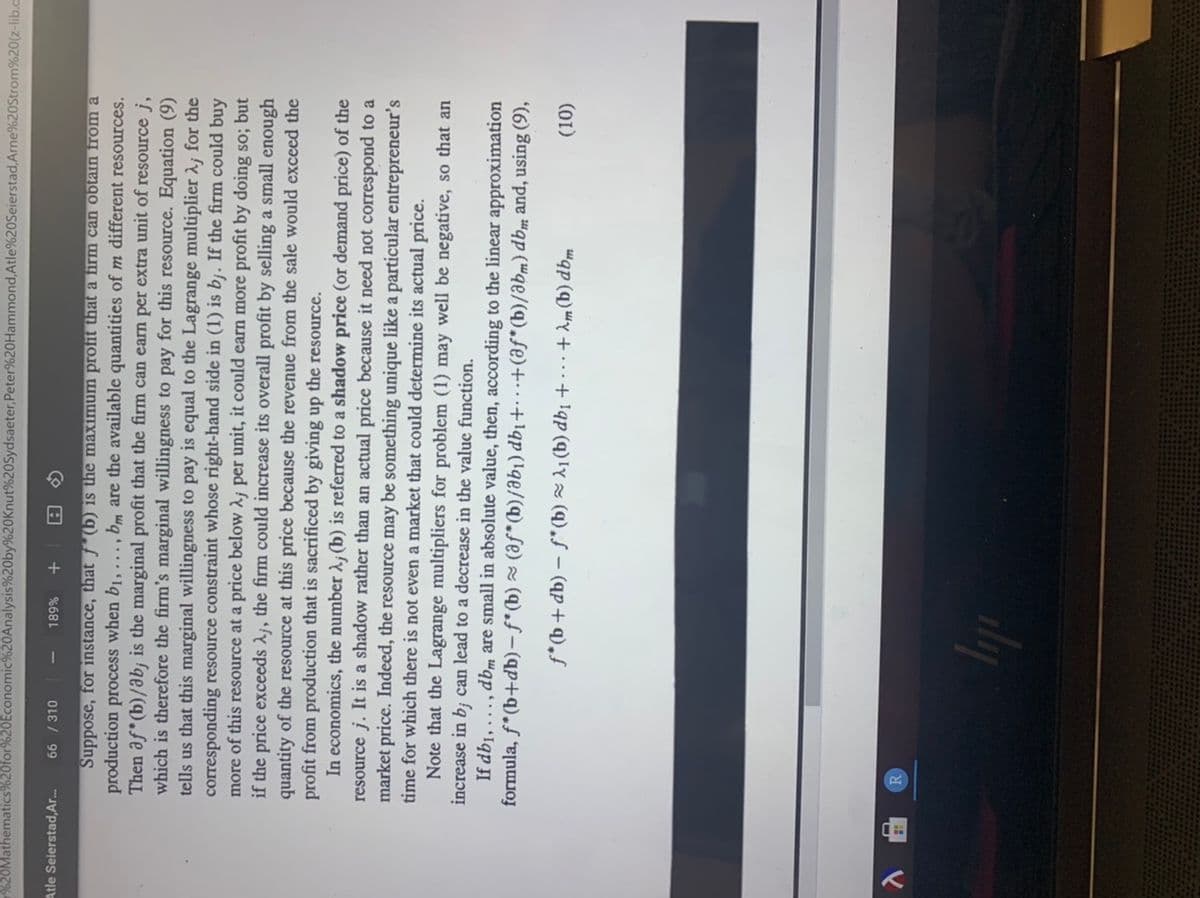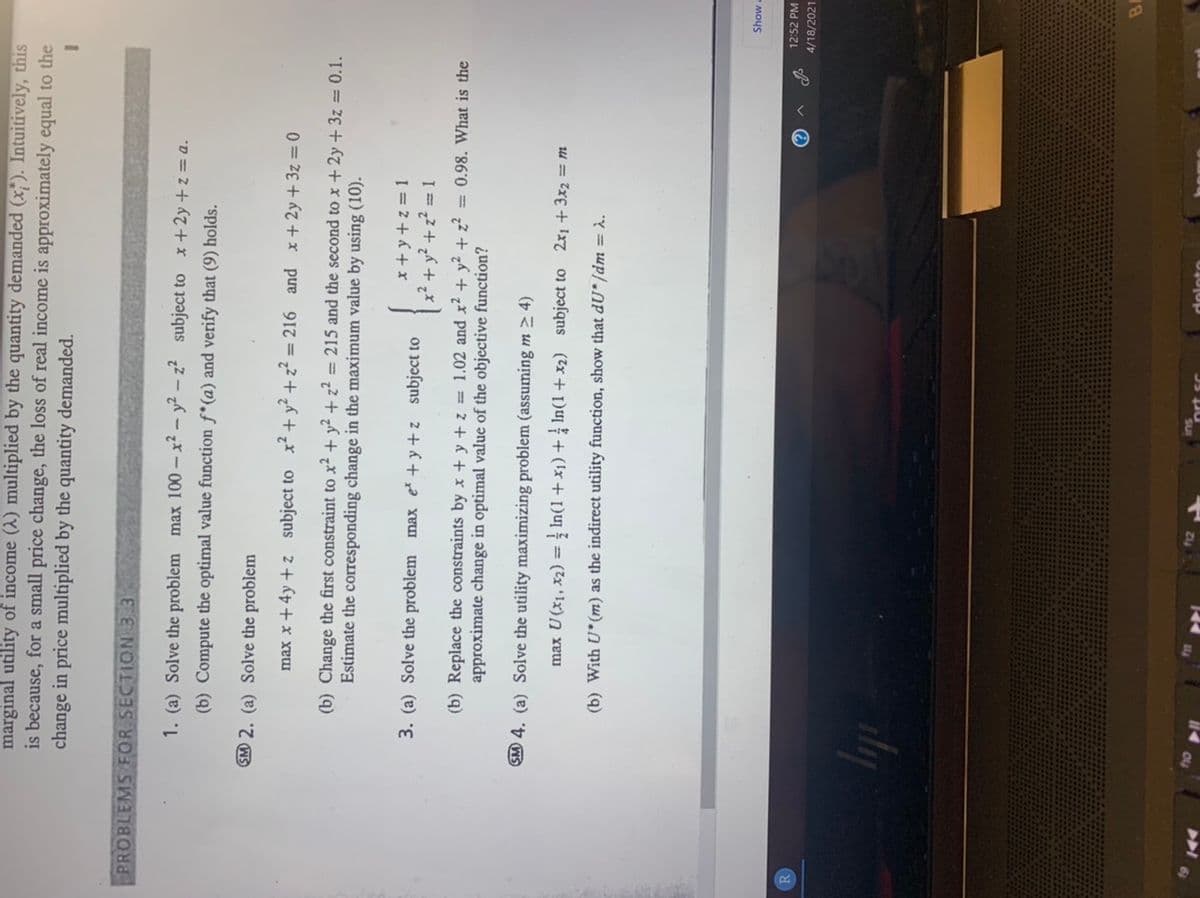SM 2. (a) Solve the problem max x +4y +z subject to x+ y +z? = 216 and x (b) Change the first constraint to x? + y? + z? = 215 and the seca Estimate the corresponding change in the maximum value by us %3D
SM 2. (a) Solve the problem max x +4y +z subject to x+ y +z? = 216 and x (b) Change the first constraint to x? + y? + z? = 215 and the seca Estimate the corresponding change in the maximum value by us %3D
Advanced Engineering Mathematics
10th Edition
ISBN:9780470458365
Author:Erwin Kreyszig
Publisher:Erwin Kreyszig
Chapter2: Second-order Linear Odes
Section: Chapter Questions
Problem 1RQ
Related questions
Concept explainers
Transformation of Graphs
The word ‘transformation’ means modification. Transformation of the graph of a function is a process by which we modify or change the original graph and make a new graph.
Exponential Functions
The exponential function is a type of mathematical function which is used in real-world contexts. It helps to find out the exponential decay model or exponential growth model, in mathematical models. In this topic, we will understand descriptive rules, concepts, structures, graphs, interpreter series, work formulas, and examples of functions involving exponents.
Question
Can you help with question 2? Note (10) is attached for reference.

Transcribed Image Text:%20Mathematics%20for%20Economic%20Analysis%20by%20Knut%20Sydsaeter,Peter%20Hammond,Atle%20Seierstad, Arne%20Strom%20(z-lib.a
Atle Seierstad,Ar..
66 / 310
%68L
+
Suppose, for instance, that f*(b) is the maximum profit that a firm can obtain from a
production process when b1, ..., bm are the available quantities of m different resources.
Then af* (b)/ab; is the marginal profit that the firm can earn per extra unit of resource j,
which is therefore the firm's marginal willingness to pay for this resource. Equation (9)
tells us that this marginal willingness to pay is equal to the Lagrange multiplier 2; for the
corresponding resource constraint whose right-hand side in (1) is b¡. If the firm could buy
more of this resource at a price below A¡ per unit, it could earn more profit by doing so; but
if the price exceeds Aj, the firm could increase its overall profit by selling a small enough
quantity of the resource at this price because the revenue from the sale would exceed the
profit from production that is sacrificed by giving up the resource.
In economics, the number ; (b) is referred to a shadow price (or demand price) of the
resource j. It is a shadow rather than an actual price because it need not correspond to a
market price. Indeed, the resource may be something unique like a particular entrepreneur's
time for which there is not even a market that could determine its actual price.
Note that the Lagrange multipliers for problem (1) may well be negative, so that an
increase in b; can lead to a decrease in the value function.
If db1, ..., dbm are small in absolute value, then, according to the linear approximation
formula, f*(b+db) – f* (b) ~ (af*(b)/ab¡) db1+ ..+(af* (b)/abm) dbm and, using (9),
(10)
"ap (q) "Y + ...+ !qp (q) 'Y (q),f – (qp + q),f
dy

Transcribed Image Text:marginal utility of income (A) multiplied by the quantity demanded (x;). Intuitively, this
is because, for a small price change, the loss of real income is approximately equal to the
change in price multiplied by the quantity demanded.
PROBLEMS FOR SECTION 3 3
1. (a) Solve the problem max 100 – x² - y² – z² subject to x + 2y + z = a.
(b) Compute the optimal value function f*(a) and verify that (9) holds.
SM 2. (a) Solve the problem
max x + 4y + z subject to x² + y² + z² = 216 and x+ 2y +3z = 0
%3D
(b) Change the first constraint to x² + y² + z² = 215 and the second to x + 2y + 3z = 0.1.
Estimate the corresponding change in the maximum value by using (10).
3. (a) Solve the problem max e +y +z subject to
I = 2 + 6 + x
x2 + y?.
+z? = 1
(b) Replace the constraints by x + y + z = 1.02 and x2 + y? + z? = 0.98. What is the
approximate change in optimal value of the objective function?
SM 4. (a) Solve the utility maximizing problem (assuming m > 4)
max U(x1, x2) = In(1+ x1) + In(1 + x2) subject to 2x1 + 3x2 = m
(b) With U*(m) as the indirect utility function, show that dU* /dm = .
Show a
12:52 PM
R
4/18/2021
dy
Expert Solution
This question has been solved!
Explore an expertly crafted, step-by-step solution for a thorough understanding of key concepts.
This is a popular solution!
Trending now
This is a popular solution!
Step by step
Solved in 4 steps with 4 images

Knowledge Booster
Learn more about
Need a deep-dive on the concept behind this application? Look no further. Learn more about this topic, advanced-math and related others by exploring similar questions and additional content below.Recommended textbooks for you

Advanced Engineering Mathematics
Advanced Math
ISBN:
9780470458365
Author:
Erwin Kreyszig
Publisher:
Wiley, John & Sons, Incorporated

Numerical Methods for Engineers
Advanced Math
ISBN:
9780073397924
Author:
Steven C. Chapra Dr., Raymond P. Canale
Publisher:
McGraw-Hill Education

Introductory Mathematics for Engineering Applicat…
Advanced Math
ISBN:
9781118141809
Author:
Nathan Klingbeil
Publisher:
WILEY

Advanced Engineering Mathematics
Advanced Math
ISBN:
9780470458365
Author:
Erwin Kreyszig
Publisher:
Wiley, John & Sons, Incorporated

Numerical Methods for Engineers
Advanced Math
ISBN:
9780073397924
Author:
Steven C. Chapra Dr., Raymond P. Canale
Publisher:
McGraw-Hill Education

Introductory Mathematics for Engineering Applicat…
Advanced Math
ISBN:
9781118141809
Author:
Nathan Klingbeil
Publisher:
WILEY

Mathematics For Machine Technology
Advanced Math
ISBN:
9781337798310
Author:
Peterson, John.
Publisher:
Cengage Learning,

